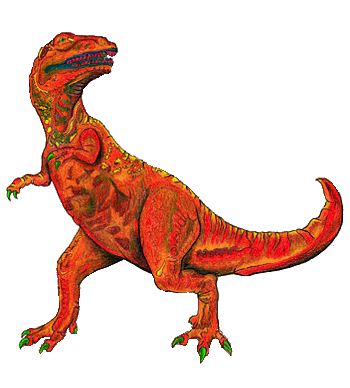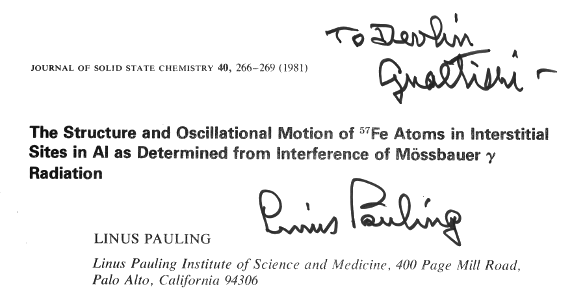Godzilla, King of the GMOs
June 4, 2014
When I was a
child in the
1950s, one of the few ways that
parents could entertain themselves was to prepare the children for
bedtime and then pile into the
family automobile for a trip to the
drive-in theater. The drive-in our family frequented had a
waterfall on the
non-optical side of the outdoor
screen lighted by
colored lights. The effect was similar to the nighttime view of
Niagara Falls, another popular attraction in the
Upstate New York region in those times
Those were the days before the
MPAA film rating system, and the hope was that the children would fall asleep from
boredom before there were any "PG-13" scenes. One memorable film I saw at age seven would surely have been rated PG-13, but not for any
sexual content. This was the 1954 film,
Them!,
Gordon Douglas, Director.[1]
This
black-and-white science fiction film was a story about
ants,
mutated by
radiation from
nuclear weapons testing, growing to tremendous size. The world was saved by an aged
myrmecologist, played by
Edmund Gwenn (
Santa from
Miracle on 34th Street) and his
daughter colleague.
Gender equality in the
sciences existed in 1954, at least in the
cinema.
That same year saw the release of the first film about another creature born from nuclear weapon radiation, the
monster,
Godzilla. The film,
Godzilla (Gojira),[2]
Ishirô Honda, Director, was edited for
American audiences as
Godzilla, King of the Monsters![3] This year has witnessed
another Godzilla film, the most interesting aspect of which is that Godzilla
got fatter after he emigrated to the US.

Godzilla is undoubtedly based on the Tyrannosaurus, proportioned to allow its being played by an actor in a suit.
This meant short, stocky legs, and a more upright posture.
(Colored pencil drawing of a Tyrannosaurus by Hannes Grobe, via Wikimedia Commons.)
Them! and Godzilla appeared just a year after
Watson and
Crick's 1953
Nature paper, "
Molecular Structure of Nucleic Acids: A Structure for Deoxyribose Nucleic Acid," which revolutionized
biology.[4] This paper explained
why radiation could
mutate life forms, but the fact that it did was known long before then.
An important pre-discovery observation of radiation
mutagenesis (pre-discovery, since
nuclear radiation was not then known) was that of
Paracelsus, who in 1567 surmised that an unidentified substance in
mined ore, now known to be
radon gas, caused
disease in
miners. In 1927,
Hermann Muller's experiments showed that
X-rays can cause mutations in
fruit flies.
In 1905, shortly after
natural radioactivity was discovered,
Dutch botanist,
Hugo de Vries, experimented with the affect of
radium on
plant growth. In 1908, Charles Stuart Gager published the book,
Effects of the rays of radium on plants.[5] The
United States and the
Soviet Union looked at the affect of
cosmic rays on
seeds and plants as soon as it was feasible to send objects into
space for subsequent retrieval. Starting in 1930,
gamma rays were used in mutation experiments.
The
nuclear arms race at the end of
World War II led to the above-ground testing of hundreds of
nuclear weapons. These
explosions discharged huge quantities of
radioactive isotopes into the
atmosphere with little thought about the consequence. A novel experiment, called the
Baby Tooth Survey, looked at the level of the radioactive isotope
strontium-90 (90Sr) in the
baby teeth of children in the period before, and after, nuclear testing.[6]
Strontium has
chemical properties similar to
calcium, and it enters the
food chain from
water and
dairy products to be deposited in
bones and
teeth. Results of the survey,
published in 1961, showed a steady increase in
90Sr in children's teeth from 1950 onwards, with children born in 1963 having fifty times the isotope level than children born before nuclear testing.
A public outcry, led by
chemist,
Linus Pauling (1901-1994), among others, led to a nuclear test moratorium, followed by the
ratification of the
Partial Nuclear Test Ban Treaty in 1963. Pauling was awarded the 1962
Nobel Peace Prize for his activism for this cause. Pauling was previously awarded the
Nobel Prize in Chemistry in 1954.

When publications become all electronic, we'll miss having mementos such as this. Linus Pauling kindly autographed a reprint of one of his papers for me in 1981. Linus Pauling, "The structure and oscillational motion of 57Fe atoms in interstitial sites in Al as determined from interference of Mössbauer γ radiation," Journal of Solid State Chemistry, vol. 40, no. 3 (December, 1981), pp. 266-269.
Radiation mutagenesis is a hit-or-miss technique, since you don't know what mutations will appear. All this changed when
scientists became capable of selective modification of
DNA, leading to the new field of
genetic engineering and
genetically modified organisms (GMOs). This ability also led to the realization that it might be possible to
accidentally release some nasty new
organism into the wild. Scientists are generally good
futurists, so they decided to act promptly on safeguards. Of course, something similar could have happened with
random mutation, too.
Principal participants in genetic modification assembled in 1975 at the
Asilomar Conference on Recombinant DNA to draft
safety recommendations for such
research. This allowed a more reasoned rule making by
government agencies such as the
US Environmental Protection Agency and
Food and Drug Administration (FDA) in subsequent years. This was followed in 2003 by the
Cartagena Protocol on Biosafety, an equivalent international safety effort approved by 157 countries who use it as a basis for their own domestic regulations.
This brings us back to Godzilla, who was "King of the Monsters" in the 1950s, but could have been called "King of the GMOs" if genetic modification was better known at the time. There's reason to be cautious about GMOs, and we can only hope the
government regulators are doing their job in that regard. Some of the non-scientist public, however, simply equates GMOs with something like Godzilla, not knowing the benefits of GMO research.
Probably the most important GMOs are
genetically modified bacteria used in the production of
pharmaceuticals. As early as 1978,
Herbert Boyer at the
University of California, San Francisco, inserted a
gene for production of
human insulin into
E. coli. Bacteria have subsequently been used to produce pharmaceuticals such as
human growth hormone.

Non-GMO baking powder?
This brand of baking powder, a mixture of monocalcium phosphate and sodium bicarbonate, has cornstarch added to prevent caking.
The cornstarch is derived from non-GMO corn.
(Photo by Lou Sander, via Wikimedia Commons.)
![]()
References:
- Them! (1954) on the Internet Movie Database.
- Godzilla ("Gojira," 1954) on the Internet Movie Database.
- Godzilla, King of the Monsters! (1956) on the Internet Movie Database.
- J. D. Watson & F. H. C. Crick, "Molecular Structure of Nucleic Acids: A Structure for Deoxyribose Nucleic Acid," Nature, vol. 171, no. 4356 (April 25, 1953), pp. 737-738. A PDF file is available, here.
- Charles Stuart Gager, "Effects of the rays of radium on plants," New York, 1908, via CiteBank.
- Louise Zibold Reiss, "Strontium-90 Absorption by Deciduous TeethAnalysis of teeth provides a practicable method of monitoring strontium-90 uptake by human populations," Science, vol 134, no 3491 (November 24, 1961), pp. 1669-1673.
- Adrian McCoy, "60 years of Godzilla mayhem," Pittsburgh Post-Gazette, May 15, 2014.
- Tim Martin, "Godzilla: why the Japanese original is no joke," Telegraph (UK), May 15, 2014.
Permanent Link to this article
Linked Keywords: Child; 1950s; parent; bedtime; family; automobile; drive-in theater; waterfall; optics; non-optical; projection screen; colored; electric light; Niagara Falls; Upstate New York; MPAA film rating system; boredom; sexual; Them!; Gordon Douglas; black-and-white; science fiction film; ant; mutation; mutated; ionizing radiation; nuclear weapons testing; myrmecology; myrmecologist; Edmund Gwenn; Santa Claus; Miracle on 34th Street; daughter; colleague; Gender equality; science; cinema; monster; Godzilla; Ishirô Honda; American; Godzilla, King of the Monsters!; Godzilla (2014 film); obesity in the United States; Tyrannosaurus; actor; leg; colored pencil; drawing; Hannes Grobe; Wikimedia Commons; James D. Watson; Francis Crick; Nature; Molecular Structure of Nucleic Acids: A Structure for Deoxyribose Nucleic Acid; biology; life form; mutagenesis; radioactive decay; nuclear radiation; Paracelsus; ore; radon gas; disease; miner; Hermann Muller; experiment; X-rays; Drosophila melanogaster; fruit fly; natural radioactivity; Dutch; botany; botanist; Hugo de Vries; radium; plant growth; Effects of the rays of radium on plants; United States; Soviet Union; cosmic rays; seed; outer space; gamma ray; nuclear arms race; World War II; nuclear weapon; explosion; radionuclide; radioactive isotope; atmosphere of Earth; Baby Tooth Survey; strontium-90 (90Sr); deciduous teeth; baby teeth; strontium; chemical properties; calcium; food chain; water; dairy product; bone; teeth; scientific literature; publish; chemist; Linus Pauling (1901-1994); ratification; Partial Nuclear Test Ban Treaty; Nobel Peace Prize; Nobel Prize in Chemistry; electronic journal; souvenir; memento; autograph; reprint; scientist; DNA; genetic engineering; genetically modified organism; accident; >organism; futurist; randomness; random; Asilomar Conference on Recombinant DNA; safety; research; government agency; US Environmental Protection Agency; Food and Drug Administration; Cartagena Protocol on Biosafety; government regulation; genetically modified bacteria; pharmaceutical; Herbert Boyer; University of California, San Francisco; gene; human; insulin; Escherichia coli; E. coli; human growth hormone; baking powder; Lou Sander.